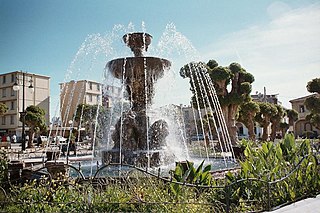
Oea was an ancient city in present-day Tripoli, Libya. It was founded by the Phoenicians in the 7th century BC and later became a Roman–Berber colony. As part of the Roman Africa Nova province, Oea and surrounding Tripolitania were prosperous. It reached its height in the 2nd and 3rd centuries AD, when the city experienced a golden age under the Severan dynasty in nearby Leptis Magna. The city was conquered by the Rashidun Caliphate with the spread of Islam in the 7th century and came to be known as Tripoli during the 9th century.
Thapsus, also known as Tampsus and as Thapsus Minor to distinguish it from Thapsus in Sicily, was a Carthaginian and Roman port near present-day Bekalta, Tunisia.

Cherchell is a town on Algeria's Mediterranean coast, 89 kilometers (55 mi) west of Algiers. It is the seat of Cherchell District in Tipaza Province. Under the names Iol and Caesarea, it was formerly a Roman colony and the capital of the kingdoms of Numidia and Mauretania.

Assuras, sometimes given as Assura or Assur, was a town in the Roman province of Proconsular Africa.

Aquae Regiae was a Roman town in the Roman province of Byzacena, during the Roman Empire and into late antiquity. The Latin adjective referring to it is Aquaregiensis.

Abitinae was a town in the Roman province of Africa Proconsularis and is famed for the Martyrs of Abitinae.

Djinet, the classical Cissi, is a port town and commune in the Bordj Menaïel District of Boumerdès Province, Algeria, east of the mouth of the Isser River and around Cape Djinet. As of 2008, the population of the municipality is 21,966.

Quiza also known as Vuiza (Βούϊζα), which Pliny the Elder called Quiza Xenitana, was a Roman–Berber colonia, located in the former province of Mauretania Caesariensis. The town is identified with ruins at Sidi Bellater, Algiers.

Cartennae or Cartenna was an ancient Berber, Carthaginian, and Roman port at present-day Ténès, Algeria. Under the Romans, it was part of the province of Mauretania Caesariensis.
Nicives, identifiable with N'Gaous in Batna Province, Algeria, was an ancient Roman town of the Roman province of Numidia.

Vallitanus or Vallis was an ancient Roman–Berber colonia in Carthage, Tunisia. The town is identified with ruins at Sidi Medien, where are located the remains of a Roman theatre, and a number of Roman inscriptions bearing witness to the town's name, and some local officials of the time can be found near the theatre.

Ounga, also known as Younga and Jounga, is an archaeological site on the Mediterranean coast of Tunisia, located 45 km (28 mi) south of Sfax along the Mediterranean coast. The area is also known for its oil fields.
Drusiliana was a civitas (town) of Roman North Africa. Bingham called it a city of the Roman province of Mauretania Caesariensis. An inscription of Constantine the Great was found in the city ruins and it appears on the Tabula Peutingeriana The town has been tentatively identified with ruins near Khanguet-el-Kdim in northern Algeria. Located at 36.249547°N 8.907667°E. Epigraphical evidence suggest Constantine the Great undertook some works in the city in 312AD.

Cubda was an ancient city in Tunisia. It is a titular bishopric of the Roman Catholic Church.
Cabarsussi, was an ancient civitas (municipality) and bishopric in the Roman province of Byzacena, that is tentatively identifiable with ruins at Drâa-Bellouan in modern Tunisia. The current bishop is Terence Robert Curtin, auxiliary bishop of Melbourne.

Iomnium was a Phoenician, Carthaginian, and Roman port on Algeria's Mediterranean coast at the site of present-day Tigzirt.
Rusazus was a Phoenician, Carthaginian, and Roman town located near Cape Corbelin, Algeria. Its ruins are near the town of Azeffoun.
The diocese of Siccesi is a suppressed and titular see of the Roman Catholic Church.
Timici was a Phoenician, Numidian, and Roman town located in present-day Ain Matboul, Algeria .
The Diocese of Vittoriana is a suppressed and titular see of the Roman Catholic Church.











